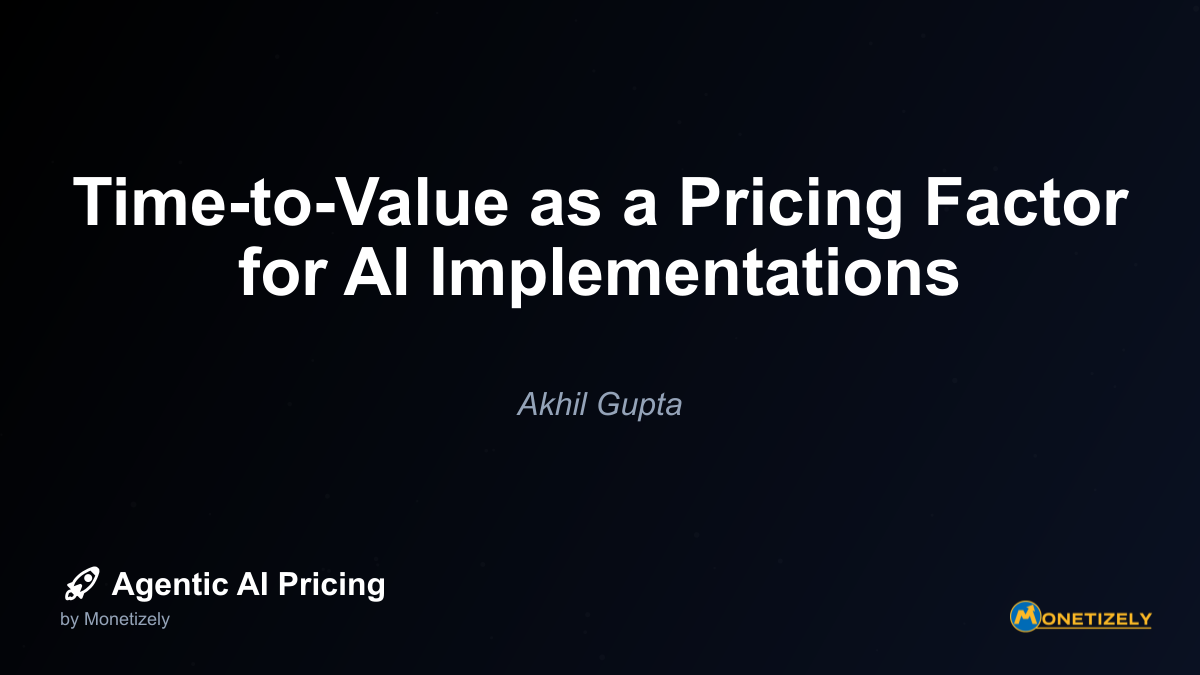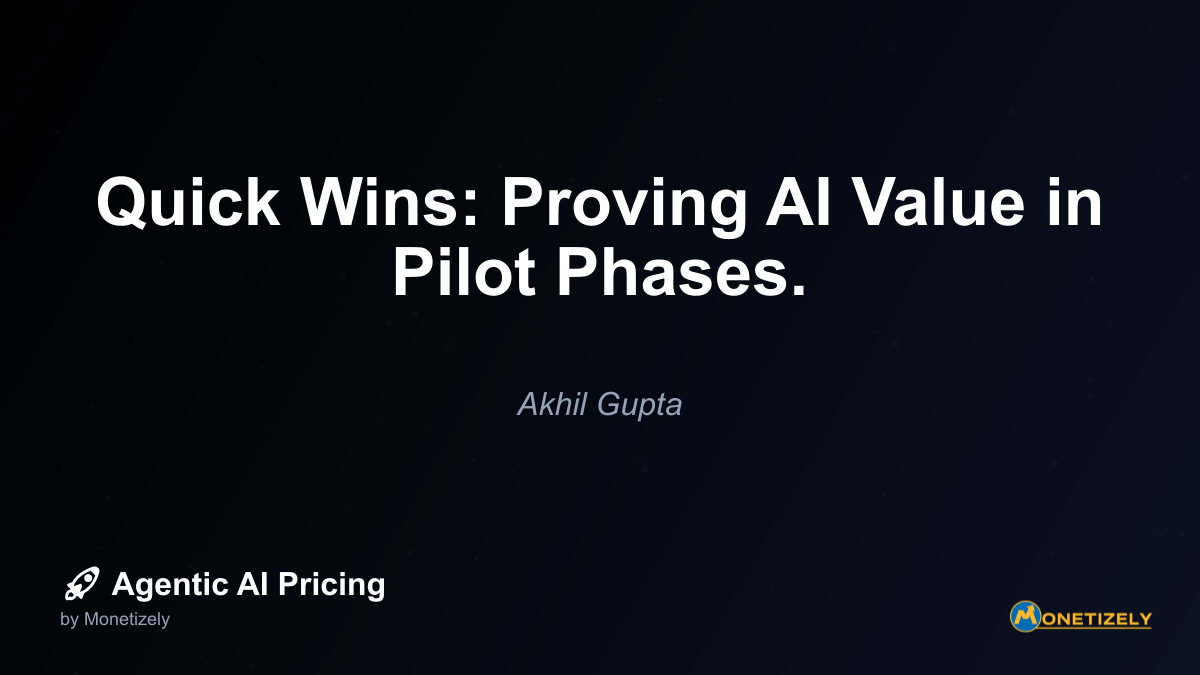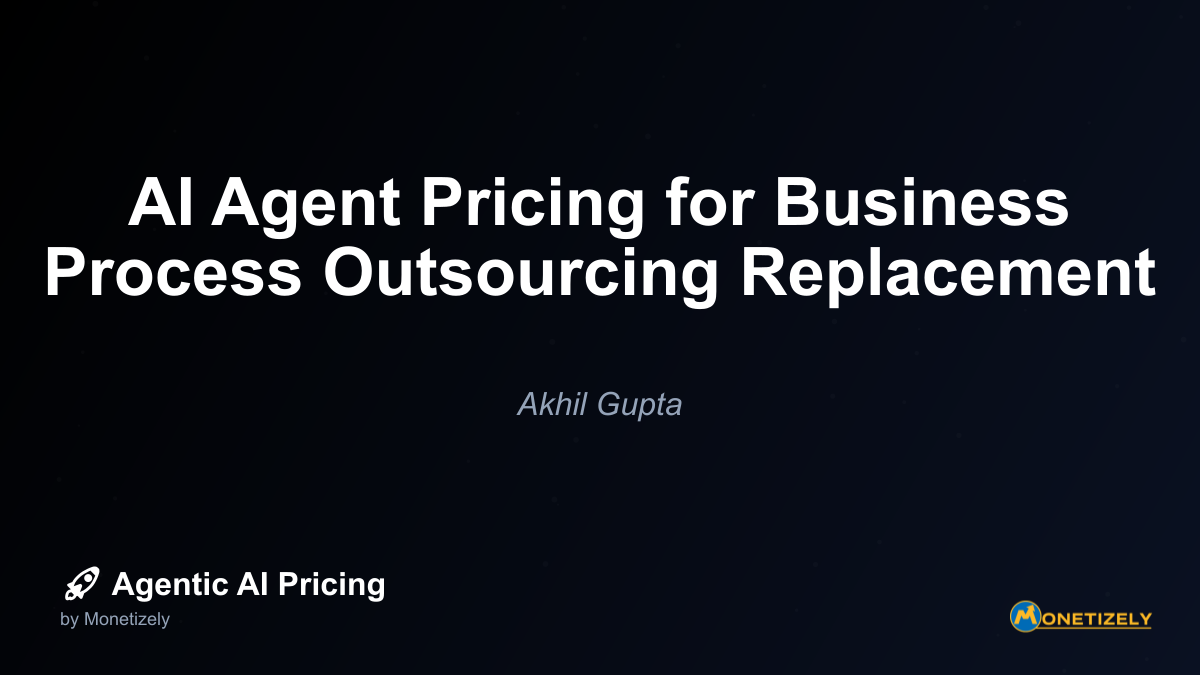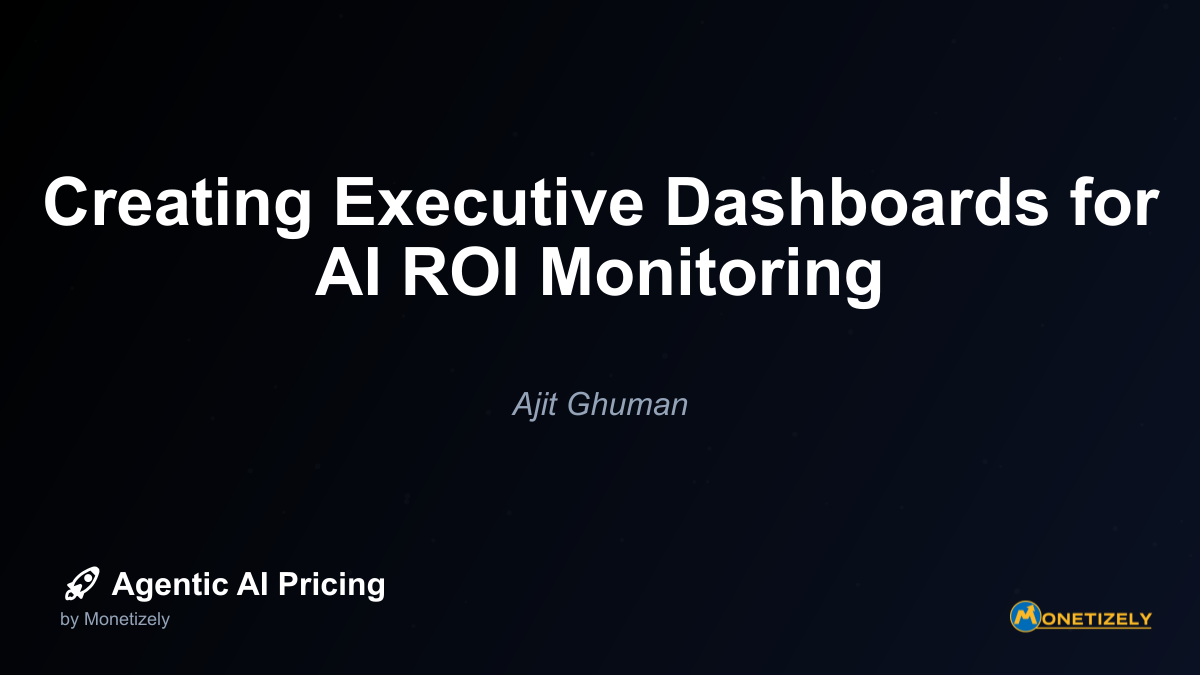· Akhil Gupta · ROI & Value · 13 min read
Time-to-Value as a Pricing Factor for AI Implementations
AI and SaaS Pricing Masterclass
Learn the art of strategic pricing directly from industry experts. Our comprehensive course provides frameworks and methodologies for optimizing your pricing strategy in the evolving AI landscape. Earn a professional certification that can be imported directly to your LinkedIn profile.

In today’s fast-paced business environment, the speed at which AI implementations deliver tangible benefits has become a critical factor in pricing strategies. Organizations no longer have the luxury of waiting months or years to realize returns on their AI investments. This shift has propelled time-to-value (TTV) to the forefront of AI pricing considerations, fundamentally changing how vendors structure their offerings and how customers evaluate potential solutions.
The acceleration of AI adoption across industries has created a competitive landscape where implementation speed and rapid value realization are key differentiators. According to recent research, the global AI market was valued at $279.2 billion in 2024 and is projected to exceed $1.8 trillion by 2030, growing at approximately 36% CAGR. This explosive growth is driving organizations to seek AI solutions that not only deliver powerful capabilities but do so within timeframes that align with business objectives and budget cycles.
This deep dive explores how time-to-value considerations are reshaping AI pricing models, the factors that influence implementation speed, and strategies for optimizing the balance between cost, capability, and time-to-benefit. We’ll examine emerging pricing frameworks, industry-specific approaches, and practical methodologies for both vendors and customers to align AI investments with value realization timelines.
Understanding Time-to-Value in AI Implementations
Time-to-value (TTV) refers to the duration between the initial investment in an AI solution and the point at which it begins delivering measurable business benefits. In the AI context, this metric has taken on heightened importance due to the significant upfront investments often required and the transformative potential these technologies promise.
The Evolution of TTV as a Pricing Factor
Traditionally, enterprise software was priced based on perpetual licenses or seat-based subscription models that had little connection to how quickly value was realized. However, the AI landscape has evolved significantly:
From capability to outcome focus: Early AI pricing centered on technical capabilities and processing power. Modern approaches increasingly tie pricing to specific business outcomes and the speed at which they’re achieved.
From long-term to accelerated ROI: While early AI adopters accepted longer payback periods, competitive pressures now demand faster returns, with organizations expecting significant benefits within 6-12 months rather than years.
From technical to business metrics: Evaluation criteria have shifted from model accuracy and technical performance to concrete business impacts like revenue growth, cost reduction, and operational efficiency.
According to research from 2023-2025, this evolution reflects broader market maturity, with AI funding having peaked in 2024 at $100.4 billion across 4,505 deals. The focus has shifted from speculative expansion to refining and scaling existing AI applications with clearer ROI and faster business impact.
Key Factors Influencing Time-to-Value in AI
Several critical factors determine how quickly an AI implementation can deliver tangible benefits:
1. Upfront Costs and Investment Structure
The initial investment required for AI implementation directly impacts TTV by affecting the breakeven point. Higher upfront costs extend the time needed to achieve positive ROI, while more distributed investment models can accelerate perceived value. Recent research indicates that organizations implementing modular AI solutions with cloud-based SaaS pricing models have reduced their TTV to under 6 months, compared to 12-18 months for traditional on-premises deployments.
2. Implementation Complexity and Integration Requirements
The complexity of integrating AI solutions with existing systems and workflows significantly impacts TTV. Solutions requiring extensive customization or data preparation extend the implementation timeline, delaying value realization. Organizations implementing a fast POC-to-deployment pipeline with agile project management have seen significant accelerations in TTV compared to traditional waterfall approaches.
3. Data Readiness and Quality
AI performance is heavily dependent on data quality and availability. Organizations with well-structured, clean data repositories can implement AI solutions more quickly than those requiring extensive data preparation work. McKinsey reports that 47% of executives see slow AI deployment driven by skill shortages and resource constraints, with data preparation being a significant bottleneck.
4. Skill Availability and Training Requirements
The availability of AI expertise, both for implementation and ongoing operation, directly affects TTV. Solutions requiring specialized skills that aren’t readily available within the organization can delay deployment and value realization. Companies increasing AI spending (55% expect >10% increase in investment by 2025) are also emphasizing workforce training to close AI skill gaps, directly improving TTV.
5. Scalability and Adaptability
Solutions that can scale easily from pilot to enterprise-wide deployment enable faster value realization across the organization. Similarly, adaptable solutions that can evolve with changing business needs provide more sustainable value over time.
Emerging AI Pricing Models Optimized for Time-to-Value
The emphasis on accelerating time-to-value has driven significant innovation in AI pricing models. Traditional approaches like perpetual licensing or basic subscriptions are giving way to more flexible, value-aligned structures.
Subscription-Based Models with Time-to-Value Incentives
Subscription models remain popular but are evolving to incorporate TTV considerations:
- Graduated pricing tiers: Pricing structures that start with lower entry points and increase as value is demonstrated, reducing initial investment barriers
- Success-based escalation: Subscription costs that increase only after predefined success metrics are achieved
- Time-limited discounts: Reduced pricing during initial implementation phases to lower entry barriers
These approaches help reduce financial risk during the critical early implementation period when value is still being established. According to recent industry data, seat-based pricing is declining, dropping from 21% to 15% of companies in one year, while hybrid and usage-based models grew to 41%, reflecting a move to pricing that scales with actual AI-generated value.
Usage and Outcome-Based Pricing
Usage and outcome-based pricing models directly tie costs to value realization:
- Pay-per-use: Charging based on actual system usage (API calls, processing time, etc.)
- Token-based pricing: Pre-purchased “AI credits” that are consumed based on usage, as implemented by companies like HubSpot
- Output-based pricing: Charging per AI-generated output (e.g., Copy.ai’s per-paragraph model)
- Outcome-based pricing: Fees directly tied to measurable business outcomes (cost savings, revenue generation, etc.)
These models align vendor compensation with customer value, creating shared incentives for rapid implementation and effectiveness. For example, companies like Copy.ai use output-based pricing (charging per content paragraph generated) to tie charges directly to value delivered, optimizing gross margins by efficient cloud cost tracking.
Hybrid Models Balancing Risk and Reward
Many organizations are adopting hybrid pricing approaches that combine elements of multiple models:
- Base subscription + usage components: A foundational fee plus variable charges based on actual usage
- Minimum commitments with outcome accelerators: Guaranteed minimum payments with additional fees tied to exceeding performance thresholds
- Phased implementation pricing: Different pricing structures for different implementation phases
These hybrid approaches provide vendors with revenue predictability while giving customers flexibility and aligning costs with value realization. Enterprise SaaS vendors, including Salesforce and Microsoft, are largely experimenting with AI feature pricing, balancing between embedding AI value into existing subscriptions or creating new distinct AI product pricing lines.
Industry-Specific Approaches to Time-to-Value in AI Pricing
Different industries have unique value drivers and implementation considerations that influence how time-to-value is incorporated into AI pricing strategies.
Healthcare: Balancing Clinical Impact with Implementation Realities
In healthcare, AI implementations must navigate complex regulatory environments, integration with critical clinical systems, and high standards for accuracy and reliability. Time-to-value considerations in healthcare AI pricing include:
- Clinical outcome acceleration: Pricing tied to improvements in diagnostic speed or treatment initiation
- Phased implementation pricing: Graduated pricing that scales with clinical adoption and proven outcomes
- Risk-sharing models: Pricing structures that share financial risk during validation phases
For example, AI diagnostic tools are increasingly priced by the number of cases processed or time saved in diagnosis, emphasizing faster outcomes that improve patient care. This approach recognizes the high stakes in healthcare implementation while acknowledging the significant value of accelerated clinical insights.
Financial Services: Rapid Returns in Risk and Compliance
Financial institutions often implement AI for fraud detection, risk assessment, and regulatory compliance—areas where speed of implementation directly impacts business outcomes. Key TTV pricing approaches include:
- Fraud reduction incentives: Pricing tied to the speed and volume of fraud detection
- Compliance acceleration bonuses: Price incentives for reducing compliance reporting cycles
- Risk-adjusted pricing: Fees that reflect the risk profile being managed
AI fraud detection systems are typically charged by transactions scanned or frauds prevented, reflecting TTV in risk mitigation. This approach recognizes that every day of delayed implementation represents potential financial losses from undetected fraud or compliance issues.
Retail: Connecting AI to Revenue and Inventory Optimization
In retail, AI implementations often focus on demand forecasting, inventory optimization, and personalized marketing—areas with direct revenue impact. Time-to-value pricing considerations include:
- Seasonal implementation timing: Pricing that reflects implementation timing relative to high-value retail periods
- Revenue lift sharing: Fee structures that share in incremental revenue generated
- Inventory efficiency bonuses: Pricing tied to improvements in inventory turnover and reduction in stockouts
AI-driven dynamic pricing and replenishment solutions are increasingly priced according to inventory turnover rate improvements and reduced stockouts. This approach recognizes the direct connection between implementation speed and bottom-line retail metrics.
Manufacturing: Minimizing Downtime and Optimizing Operations
Manufacturing AI implementations often focus on predictive maintenance, quality control, and process optimization—areas where operational efficiency is paramount. TTV pricing approaches include:
- Downtime reduction incentives: Pricing tied to reductions in unplanned downtime
- Quality improvement bonuses: Fees linked to defect reduction and quality improvements
- Process efficiency sharing: Pricing that shares in documented efficiency gains
AI predictive maintenance solutions are frequently priced by machines monitored or downtime hours avoided, aligning cost with operational uptime benefits. This approach recognizes that every hour of accelerated implementation represents potential savings from avoided production disruptions.
Measuring and Optimizing Time-to-Value in AI Pricing
Effectively incorporating time-to-value into AI pricing requires robust frameworks for measurement, optimization, and ongoing refinement.
Frameworks for Measuring Time-to-Value
Organizations need structured approaches to define, measure, and track time-to-value in AI implementations:
Multi-Stage KPI Framework
This framework tracks KPIs across different implementation phases:
- Initial stage: Focus on data quality (e.g., error rate), AI model accuracy, and user adoption metrics to ensure foundational readiness
- Intermediate stage: Measure decision impact (price adjustment frequency, alignment with business goals, user satisfaction)
- Advanced stage: Track financial outcomes (profit margin, sales volume, market share, elasticity)
This staged approach recognizes that value realization occurs incrementally and allows for appropriate pricing adjustments at each phase.
ROI and Business Value Framework
This framework establishes clear connections between AI implementation and business outcomes:
- Baseline key performance indicators before AI deployment
- Benchmark improvements post-deployment, covering direct financial ROI (cost savings, revenue uplift) and intangible benefits
- Use total cost of ownership (TCO) accounting to balance upfront and ongoing investment with realized returns
This approach provides a comprehensive view of value realization timelines and can inform dynamic pricing adjustments.
Time-to-Market and Time-to-Value Metrics
These metrics focus specifically on implementation speed and value realization:
- Track concept-to-launch duration to reduce cycle time from idea to deployment
- Measure iteration speed – design, testing, refinement cycles – to accelerate learning loops
- Calculate the time-to-value ratio to compare how quickly revenue or efficiency gains accrue after deployment
These metrics provide clear benchmarks for evaluating and optimizing implementation speed and value realization.
Best Practices for Optimizing Time-to-Value in AI Pricing
Several key strategies can help organizations optimize the connection between pricing and time-to-value:
1. Define Clear Value Milestones
Establish specific, measurable value milestones that mark significant progress in the implementation journey:
- First meaningful value: The initial point where users experience tangible benefits
- Functional value: When the solution delivers its core intended functionality
- Expanded value: When additional capabilities or use cases are successfully implemented
- Transformative value: When the solution fundamentally changes business operations or outcomes
These milestones provide natural points for pricing transitions or adjustments based on value realization.
2. Align Pricing Structure with Implementation Phases
Design pricing structures that evolve with the implementation journey:
- Discovery and planning phase: Lower costs focused on feasibility and scoping
- Pilot implementation phase: Limited investment with clear success criteria
- Scaling phase: Expanded pricing reflecting broader deployment and value
- Optimization phase: Value-sharing models based on demonstrated outcomes
This phased approach reduces upfront investment risk while ensuring vendors are compensated as value is delivered.
3. Incorporate Flexibility for Unexpected Challenges
Build flexibility into pricing agreements to accommodate implementation realities:
- Adjustment mechanisms: Predefined processes for addressing unexpected implementation challenges
- Extension provisions: Options for extending initial terms if value realization is delayed for legitimate reasons
- Escalation procedures: Clear pathways for resolving disputes related to value delivery timelines
This flexibility acknowledges that AI implementations often encounter unforeseen challenges while maintaining accountability for value delivery.
4. Implement Continuous Monitoring and Optimization
Establish ongoing processes for tracking and optimizing time-to-value:
- Regular value assessments: Scheduled reviews of value realization against expectations
- Pricing adjustment triggers: Predefined conditions that trigger pricing discussions
- Continuous improvement mechanisms: Processes for identifying and addressing bottlenecks in value delivery
This ongoing focus ensures that pricing remains aligned with actual value delivery throughout the relationship.
Technical and Operational Considerations for Time-to-Value Optimization
Beyond pricing structures themselves, several technical and operational factors significantly impact time-to-value in AI implementations.
Infrastructure Requirements and Choices
The infrastructure supporting AI deployment directly affects implementation speed and ongoing performance:
- Cloud vs. on-premises decisions: Cloud deployments typically enable faster implementation but may have different long-term cost implications
- Scalability planning: Infrastructure that can scale seamlessly reduces delays during expansion
- Integration architecture: Well-designed APIs and connectors accelerate integration with existing systems
Organizations can choose between cloud-based platforms (offering scalability, flexibility, and access to advanced AI services) and on-premises setups (providing more control and security), or hybrid solutions depending on regulatory and business needs. Supporting infrastructure should enable automation in deployment and management (e.g., via Docker, Kubernetes, Infrastructure-as-Code) to enhance operational efficiency, reduce human error, enable rapid iteration, and maintain consistent environments from development to production.
Data Preparation and Governance
Data readiness is often the most significant factor affecting implementation timelines:
- Data quality assessment: Early evaluation of data quality and completeness
- Governance frameworks: Clear processes for data access, security, and compliance
- Preparation automation: Tools and processes to accelerate data cleaning and preparation
Costs arise from data preparation (cleaning, standardization, governance), development of AI models, and integrating AI outputs into existing business processes and systems. Integration may require API-led connectivity for seamless data flow between AI models and applications, which can involve significant engineering effort depending on legacy system complexity.
Skills and Organizational Readiness
The human and organizational aspects of AI implementation significantly impact time-to-value:
- Skills assessment and development: Identifying and addressing skill gaps early
- Change management processes: Structured approaches to organizational adoption
- Clear roles and responsibilities: Well-defined accountability for implementation success
Building or augmenting a multi-disciplinary team—including data scientists, ML engineers, software developers, and domain experts—is critical and represents a key operational investment. According to McKinsey, 47% of executives see slow AI deployment driven by skill shortages and resource constraints, with addressing talent gaps being a critical factor in improving time-to-value.
Implementation Methodology Selection
The chosen implementation approach directly affects time-to-value:
- Agile vs. waterfall considerations: Iterative approaches often deliver value more quickly
- Minimum viable product (MVP) definition: Clear scoping of initial functionality to accelerate deployment
- Continuous delivery pipelines: Automated testing and deployment to speed iterations
Organizations implementing a fast POC-to-deployment pipeline, integrating agile project management, saw significant accelerations in TTV compared to traditional approaches, with some reducing their implementation cycles by 30-50%.
Future Trends in Time-to-Value-Based AI Pricing
As the AI market continues to evolve, several emerging trends will shape how time-to-value influences pricing strategies.
Predictive Time-to-Value Models
Advanced analytics will enable more accurate prediction of implementation timelines and value realization:
- Industry-specific benchmarking: Detailed data on typical implementation timelines by industry and use case
- Organization readiness assessment: Tools to evaluate an organization’s preparedness for AI adoption
- Value realization forecasting: Predictive models for expected value delivery timelines
These capabilities will enable more precise and customized pricing structures based on expected time-to-value for specific customers and implementations.
AI-Powered Implementation Acceleration
AI itself will be applied to accelerate implementation and value realization:
- Automated data preparation: AI tools to accelerate data cleaning and preparation
- Self-optimizing models: Systems that continuously refine themselves to improve performance
- Implementation intelligence: AI-powered guidance for implementation teams
These technologies will compress implementation timelines, potentially changing expectations for time-to-value across the industry.
Ecosystem-Based Pricing Models
Comprehensive ecosystems will emerge offering end-to-end solutions with integrated pricing:
- Platform + services bundles: Combined offerings of technology and implementation services
- Industry-specific solutions: Pre-configured implementations for specific industry use cases
- Partner ecosystem pricing: Coordinated pricing across multiple vendors in an implementation ecosystem
Co-Founder & COO
Akhil is an Engineering leader with over 16+ years of experience in building, managing and scaling web-scale, high throughput enterprise applications and teams. He has worked with and led technology teams at FabAlley, BuildSupply and Healthians. He is a graduate from Delhi College of Engineering and UC Berkeley certified CTO.
Pricing Strategy Audit
Let our experts analyze your current pricing strategy and identify opportunities for improvement. Our data-driven assessment will help you unlock untapped revenue potential and optimize your AI pricing approach.




